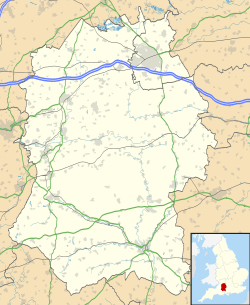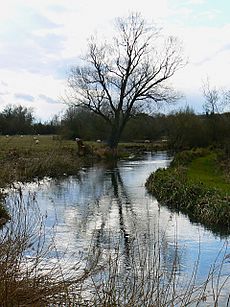Marlborough Mound facts for kids
Quick facts for kids Marlborough Mound |
|
|---|---|
| Marlborough, Wiltshire, England | |

Marlborough Mound (top) illustrated in William Stukeley's Itinerarium Curiosum.
|
|
| Coordinates | 51°25′00″N 1°44′15″W / 51.416573°N 1.737374°W |
| Type | Artificial Mound |
| Height | 19m |
| Site information | |
| Owner | Marlborough College |
| Open to the public |
Private Property |
| Condition | Earthworks remain as well as restored grotto and concrete slab at summit |
The Marlborough Mound is an ancient monument in the town of Marlborough, England. It was built during the Neolithic period, also known as the New Stone Age. This huge mound stands 19 metres (about 62 feet) tall. It is the second tallest monument of its kind in England, after Silbury Hill, which is nearby. Experts believe it was built around 2400 BC. In 1951, it was officially recognized as a Scheduled monument, meaning it is a nationally important historical site.
Marlborough Mound is part of a group of amazing Stone Age monuments in this area. These include the famous Avebury Ring, Silbury Hill, and the West Kennet Long Barrow. The mound is located near where the River Kennet flows. Today, it is found within the grounds of Marlborough College. Because it is on private land, you cannot visit it freely like other ancient sites in Wiltshire.
Over thousands of years, the mound has been used for many different things. It was once the base for a Norman castle. Later, it became a fancy garden feature for a large house. It was even part of a coaching inn and held a water tower for Marlborough College. Recently, people have become very interested in restoring and protecting this important historical site. Scientists are also studying how it connects to Silbury Hill and other ancient places in Wiltshire. Today, you can still see the earthworks, a special shell grotto, and a concrete slab at the very top.
Contents
Where is Marlborough Mound?
The Marlborough Mound is on the western side of Marlborough town. It is inside the grounds of Marlborough College. The mound is very close to the River Kennet. Other important ancient sites are also nearby. These include Silbury Hill, which is about 5 miles (8 km) to the west. There are also other mounds and burial sites like Hatfield Barrow and Manton Barrow.
The mound is over 18 metres (60 feet) tall from the ground. Its very top is 149.76 metres (491 feet) above sea level. The bottom of the mound is 83 metres (272 feet) wide. The flat top measures 31 metres (102 feet) across.
The mound's shape has changed over time. This happened as people used it for different purposes. By 1654, it was part of a grand house's gardens. The family living there, the Seymour family, changed the mound. They created a spiral path that winds around the mound from bottom to top. This path is about 1.5 metres (5 feet) wide. You need to walk around the mound four times to reach the top. There are also concrete steps on the south side for easier access today.
Experts like Joshua Pollard and Jim Leary believe the mound was not built all at once. They think it was built in stages over about 100 years. Smaller mounds were slowly made bigger using gravel and clay. So, scientists see the Neolithic mound as a project that grew over time, not just a finished structure.
In 2010, scientists took samples from the mound. They found different types of clay, like chalky, silty, and yellowish-brown clay. They also found flinty gravel. Small pieces of charcoal were also found. These charcoal pieces were used for radiocarbon dating. This method helped scientists figure out that the mound was built during the Neolithic period.
What Was the Mound Used For?
The original reason for building Marlborough Mound is not fully clear. However, we know a lot about how it was used throughout history. A popular local story says that the mound is where the wizard Merlin is buried. The town's motto even mentions Merlin's bones!
An old historian named William Stukeley thought a Roman fort might have been on the site. This was because Roman coins were found there. More Roman items were found in later digs in 1892 and 1938.
A British historian named Ronald Hutton suggests two main ideas for the mound's purpose. It could have been a platform where people spoke to a crowd for social reasons. Or, it might have had a special religious meaning for the community.
Marlborough Castle
We know for sure that a medieval tower was built on the mound. First, it was made of wood, then later of stone. The mound served as the base, called a motte, for this castle. In 1067, William the Conqueror took control of the Marlborough area. He told Roger, Bishop of Salisbury, to build a wooden motte-and-bailey castle on the mound.
More proof of the castle comes from 1070. That's when Ethelric, bishop of Selsey, was held and died there. The nearby Savernake Forest became a royal hunting ground. Marlborough Castle then became a home for kings and queens. Around 1175, stone was used to make the castle stronger.
Between 1227 and 1272, Henry III of England spent money to fix up the castle. He improved the living areas and a chapel. After Henry III died, Marlborough was no longer a favorite royal home. The castle started to fall apart after 1370. By 1541, it was in ruins. King Edward VI of England then gave the castle to the Seymour family.
Gardens and Inn
After the castle, the Seymour family developed the mound. They dug a cave and built a beautiful shell grotto inside it. They also created a spiral road to the top. Lady Hertford made the mound part of the grand gardens of her home. This shows how the mound became a type of garden feature, which was popular in Britain from the late 1500s. The shell grotto was later used as a bike shed! Three pools outside the grotto's entrance reflected sunlight inside.
After the last Duke of Somerset in that family died, the grand house became a coaching inn. It was called the Castle Inn and opened in 1751. At its busiest, 42 coaches passed through the inn every day. Marlborough was a perfect stop on the road between London and Bath.
In the 1800s and 1900s, the mound held a water tank for Marlborough College. The college was started in 1843. The water tank has since been removed.
Studying the Mound
Most of the research and ideas about the mound have happened from the late 1700s until today. Early studies used digging, while newer ones use modern core sampling. One of the first studies was by William Stukeley in 1776. He wrote about finding Roman coins at the site.
In the 1800s and early 1900s, archaeologists used traditional digging methods. In 1821, Richard C. Hoare suggested that Marlborough Mound was connected to Silbury Hill. He believed both sites were part of a larger ancient complex. Hoare also thought the mound was built in prehistoric times.
In 1892, an antler was found on the mound's slopes. More antlers were found later by H.C Brentnall, a teacher at the college. These finds supported Hoare's idea that the mound was prehistoric. They went against the idea that it was Merlin's burial site or only built for the Norman castle. Brentnall thought the chalk on the antlers meant they were buried when the mound was built. Two Roman coins were also found in the "castle ditch."
As the 1900s went on, medieval items were found. This made some people question if the mound was truly prehistoric. In 1955 and 1956, digs on the west side found medieval trash, including Norman pottery. As late as 1997, some thought the mound fit the size of a medieval castle base. An analysis of the evidence at the time suggested the mound was "essentially a medieval construction."
In the late 1900s and early 2000s, studies of the mound continued. The Royal Commission on the Historical Monuments of England surveyed the mound in 1999. In 2008, people started to think of Marlborough Mound as a possible comparison to Silbury Hill. Scientists decided that taking core samples would be the best way to find materials that could be dated.
Geotechnical Engineering Ltd helped with this in October 2010. They took six core samples, two from boreholes at the top of the mound. In a paper by Jim Leary and other experts, the mound's age was set to the second half of the third millennium BC. The earliest date for its construction was found to be between 2580 and 2470 BC.
Recently, studying the mound has led to bigger questions. How can mounds help us learn about people in Neolithic Britain? Experts from different fields are asking these questions. Archaeologist Jim Leary thinks there might be a special connection to water. His idea is based on the mound's closeness to the River Kennet, just like Silbury Hill. Rivers were very important for travel and life in the Neolithic period. Geologist Isobel Geddes also links the mound's location to water worship. Nigel Bryant suggested the mound was a monument to an Earth goddess.
Also, the time when the mound and others in Wiltshire were built matches when early English Beakers appeared. This has led to the idea that building the mound was a way for native people to show their presence during a time of social and cultural change.
Restoring the Mound
The mound is being restored partly because it had fallen into disrepair. It used to look much nicer when it was part of Lady Hertford's garden. Also, scientists are showing new interest in the site. In the 1980s, work began to fix the shell grotto. Diana Reynell oversaw this, and students from Marlborough College helped.
Much of the restoration work aims to stop the mound from collapsing. It also helps keep the mound's structure strong. Recently, more work has been done to protect the mound. This is because tree roots were making it unstable. Peter Carey, who helped manage the restoration, warned about the danger of trees growing on the mound. If a tree fell, it could destroy the whole mound.
So, by 2016, the restoration goals included removing the tree canopy. They also wanted to make the earth stable with grasses. Fresh soil was added, and a special gel was injected into the top of the mound. This gel helps hold the existing structure together. The removal of trees and planting of hedges was finished in 2020.
Marlborough Mound Trust
The Marlborough Mound Trust was started in 2000. It is the main group that helps pay for the mound's restoration. The Trust has two main goals:
- To restore, protect, and maintain the Mound at Marlborough College.
- To teach the public about the mound's archaeological and historical importance.
The Trust is a key supporter of the restoration work. For example, in 2018, they spent £87,600 on it. They also support scientific studies of the mound. They helped pay for the core sampling project that happened in October 2010.




